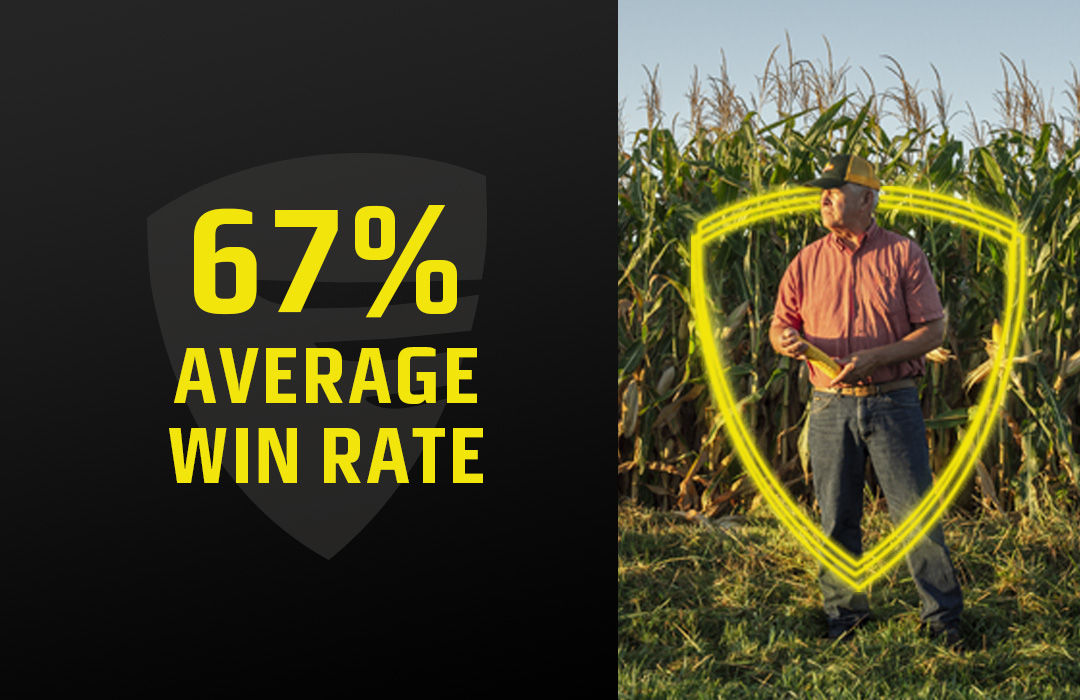DEKALB® Disease Shield
DEKALB Disease Shield technology offers the broadest protection available with protection against Goss’s wilt, northern corn leaf blight, gray leaf spot, anthracnose stalk rot and southern rust — all without sacrificing yield potential.
Featured DEKALB Disease Shield Products
- Outstanding yield potential with semi-fixed ear; consider medium-high population
- Strong Goss’s Wilt, Northern Corn Leaf Blight, and Anthracnose Stalk Rot disease tolerance package
- Strong defensive package with excellent stress tolerance, strong greensnap tolerance, and solid root and stalk strength
- Product has shown excellent staygreen and late season harvest appearance
- Outstanding yield potential with semi-fixed ear; consider medium-high population
- Strong Goss’s Wilt, Northern Corn Leaf Blight, and Anthracnose Stalk Rot disease tolerance package
- Strong defensive package with excellent stress tolerance, strong greensnap tolerance, and solid root and stalk strength
- Product has shown excellent staygreen and late season harvest appearance
- Strong disease tolerance package includes Goss’s Wilt, Northern Corn Leaf Blight, Gray Leaf Spot, and Anthracnose Stalk Rot tolerance
- Has shown western adaptation through excellent greensnap tolerance and strong Goss’s Wilt tolerance
- Excellent stalk strength and good root strength
- Semi-fixed ear type has shown a strong response to medium-high planting densities
Goss's Wilt
DEKALB® Disease Shield® technology offers the genetics you need to help keep Goss's wilt from spreading to your acres and limiting your yield potential.
Over the past 50 years, Goss's wilt has spread from the western Corn Belt across 18 states and into Canada. Its impact on yield varies based on rain, hail and wind damage, as well as other environmental risk factors, but it results in an average yield loss of 11.6% (or 18.5 bu/A).
What to look for:
Discolored vascular tissue
Browning of lower stalks
Watery lesions with wavy margins (gray-green to black in color)
Leaves with smaller "freckles" inside larger lesions that may be visible when held up to the sun
Northern Corn Leaf Blight
DEKALB® Disease Shield® technology offers the genetics you need to help keep northern corn leaf blight from spreading to your acres and limiting your yield potential.
As its name indicates, northern corn leaf blight is more common in the early summer climates of Midwestern states due to high humidity and moderate temps. But it can also be a springtime problem in southern and central Florida. On average, it can reduce yields by 7.4% (or 11.9 bu/A).
What to look for:
- Greenish-gray lesions shaped like ovals or cigars, first appearing on lower leaves and moving upward into the canopy
- Lesions can be up to 6 inches long
Gray Leaf Spot
DEKALB® Disease Shield® technology offers the genetics you need to help keep gray leaf spot from spreading to your acres and limiting your yield potential.
Causing an average 6.1% yield loss (or about 9.8 bu/A), gray leaf spot thrives in humid, warm climates, especially when the sky is overcast for days at a time. Crops throughout the Corn Belt are susceptible to it, but especially in the eastern Corn Belt and Mid-Atlantic states.
What to look for:
Small brown rectangular lesions surrounded by a yellow halo on the leaves
Brown or gray regions between major leaf veins
Gray fungal spores on the underside of leaves
Anthracnose Stalk Rot
DEKALB® Disease Shield® technology offers the genetics you need to help keep anthracnose stalk rot from spreading to your acres and limiting your yield potential.
With a 6.1% average yield loss (or about 9.7 bu/A), anthracnose stalk rot is a powerful threat to corn farmers across the nation. In fact, up to 65% of all U.S. acres are at risk. Anthracnose stalk rot likes to grow in warm temperatures with high humidity, especially in high-yield environments and high-density acres. Also notable: It can infect plants through the roots or by spores landing on the stalk.
What to look for:
"Ghosting" or dieback
Rotted stalks
Dark and soft tissues starting at the nodes
Shiny black discoloration in blotches or streaks on the stalk (also called blackened rinds)
Lodging high on the stalk
Early drydown
Southern Rust
DEKALB® Disease Shield® technology offers the genetics you need to help keep southern rust from spreading to your acres and limiting your yield potential.
It might not be talked about as much as other diseases, but southern rust can still take a big chunk out of yield potential. It accounts for 3.1% average yield loss (or 5.0 bu/A) due to its ability to inhibit photosynthesis and starch production. Growers in the southern part of the Corn Belt are at risk the most because southern rust likes warm and humid climates.
What to look for:
Small circular pustules with light-orange to reddish coloring located on the upper leaf surface
Pustules may also infect stalks, husks, ear shanks and husk leaves
Weakened stalks and accompanying stalk rot
Tested and Proven
The elite genetics of DEKALB Disease Shield products have been tested on a wide range of demanding growing conditions — including yours. Their consistent performance has been proven over four years with data from more than 30,000 comparisons.

